Show
→ summary only
→ detailed version only
→ Original Rules EN, FR, DE, NL (pdf)

In SteamRollers you are a U.S. railroad baron, not long after the Civil War. Private
investors are betting heavily on this new industry and building railways all over America.
Use the dice to build a network of railways, improve your steam engines, and grab the most
profitable delivery contracts before your opponents. Be faster and more efficient to become
the railroad emperor!
Components
200
individual player sheets
1
bag
56
goods (10 red, 10 blue, 10 green, 10 yellow, 10 grey, 6 black)
1
supply board
1
setup play aid
1
first player marker
7
dice (6 white, 1 black)
7
Action tiles
6
Order tiles
5
Starting Power tiles
Pens not included.
(You can download a file on our website to print more individual player sheets.)
Goal of the game
To win you must have more points than the other players at the end of the game. You earn
points by expanding your rail network, improving your engine, making deliveries, and
collecting action tiles.
Setup
- Give each player an individual player sheet and a pen.
- Place the supply board in the middle of the table.
-
The map consists of six regions (one Yellow, one Red, one Green, one Blue, and two
Grey). Each region has one city (a), indicated by a darker colour and die number,
and one town (b), indicated by a black circle.
-
Place all goods, except the Black ones in the bag. Draw (number of players + 2)
random goods and place them on each numbered city on the supply board. Remove goods
of the same colour as the city they were placed on. If a good is removed, it is not
replaced, unless playing with optional Coal rules. See below.
-
(Optional - Black Coal goods) In each city where at least one good was removed,
place one single black Coal good.
-
Choose a random a/b side for each action tile and place them next to the supply
board so that they are visible to all players. The tiles will stay with the same
side face-up for the rest of the game. Note: The action tile 2 marked "Solo" is
only used in solitaire play and stays in the box for normal games.
-
(Optional - Order tiles) Choose a random a/b side for each order tile and place
them next to the supply board so that they are visible to all players. The tiles
will stay with the same side face-up for the rest of the game.
- (Optional - Start Power tiles) Place the five Start Power tiles next to the board.
-
The last player to have missed a train becomes the first player. She takes the
first player marker, the black die, and a number of white dice equal to the number
of players plus one. When playing with less than five players, the remaining white
dice are not used and are put back in the box.
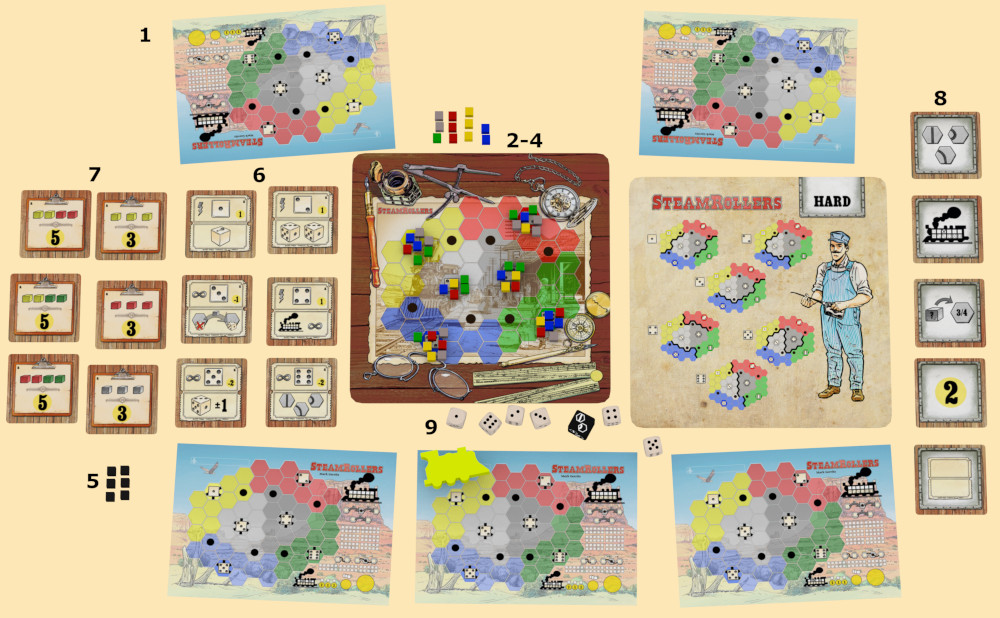
Starting power tiles (optional)
With this micro-expansion each player starts with a different starting power.
Starting with the last player and going counter-clockwise, each player picks a starting
power tile and uses it. The tiles are then placed back in the box and are not used
during the game.
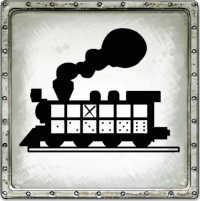 Engine:
Engine: The player may check one of her engine boxes before the start
of the game.
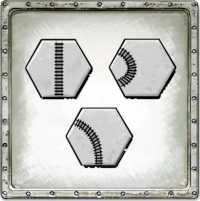 Rail:
Rail: The player may draw a rail on one of her individual sheet's hexes
before the start of the game.
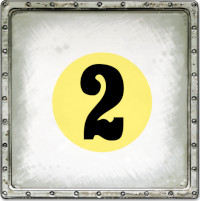 +2:
+2: The player receives two points before the start of the game. She
writes +2 on her individual sheet's scoring box to remember it.
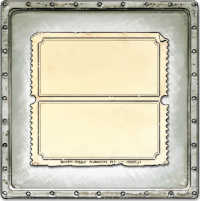 Action tile:
Action tile: The player starts the game with one of the action tiles,
turned sideways.
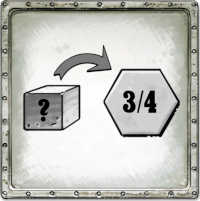 Personal delivery:
Personal delivery: The player draws a non-grey good from the bag and
places it on city 3 or 4 on her individual sheet. This is a personal good that
only she will be able to deliver.
Medium and hard game (optional)
This micro-expansion allows the players to change the board from one game to another.
For a more challenging game, roll one die and look on the corresponding chart (choose
Medium or Hard) to see which borders are blocked for this game. All players mark these
same borders on their maps. No transport of cargo is allowed across marked borders, and
connections that cross them do not score points at the end of the game. Just think of
them as big walls.
The game round
-
The start player rolls all the dice and puts them near the board so that they are
clearly visible to all players.
-
She then straightens any sideways action tiles she has, then she takes one of the
white dice and performs one action with it.
-
Afterwards, every other player in turn chooses one die and performs one action with
it. Normally there will be one white die left (exception: see action tiles). This
is the end of the game round.
-
The dice and start player token pass to the next player clockwise and a new round
begins.
Micro expansions
There are a few optional sets of rules:
-
Starting power tiles: Before the game starts, each player in reverse order
chooses a tile that provides a small bonus.
-
Medium and hard game: This adds some barriers to the map.
-
Black coal goods: These goods can be delivered to any city (they act as
wilds).
-
Order tiles: This allows players to gain extra points by being the first to
deliver specific sets of goods.
Game end
If at the end of a game round three or more cities on the supply board are empty, the game
is over. Otherwise the start player marker is passed to the left, the new start player
gathers up all the dice, and a new round begins.
Player Actions
Build track

Example : Cities 1 and 3 are connected as is the yellow town in between. Cities 1 and 5
are not connected and neither is the blue town connected to either city.
The player draws a railway track in one empty hex on her individual sheet. The white
die determines in which region the player must draw. The black die determines which
type of track the player may draw (there are always two options). Each hex may only be
drawn into once. Players can't build in a hex in which they’ve already built (no
crossings or junctions). A player's railway tracks do not need to form one single
connected network. There may be separate small networks on a player's map. Players can
even draw tracks which connect to no cities.
Cities (numbered 1-6) cannot (and do not need to) be drawn in. A track bordering on a
city connects to that city. Town hexes on the other hand can be drawn in, and a town is
only connected if there’s a railway track going through its hex. A track going through
a town hex will always pass through the town.
Choose one of the track types shown on the black die and draw that rail in one of the
empty hexes in the region identified by the white die.
Improve engine
The player crosses off the checkbox corresponding to the die she picked for her engine.
It is the total of crossed-out checkboxes that determines the strength of a player's
engine, not the printed number: each box checked improves the engine power by one. Each
die value can only be used once to upgrade a player's engine, and its maximum strength
is six. The checkboxes do not need to be crossed off in numerical order! The engine
strength indicates the maximum number of cities/towns that can be crossed/reached when
delivering goods.
Cross off the engine checkbox corresponding to the die you picked. The number of
crossed off checkboxes determines how many cities/towns your goods can pass through on
the way to their destination.
Deliver goods
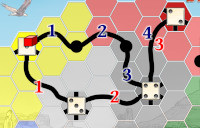
Example : A red good in city 1 must be delivered to the red city 2. This can be done
with a distance of 3 (red numbers - passing by cities 3 and 4) or a distance of 4 (blue
numbers - passing by two towns and city 4).
The white die determines the source city of the delivery. Choose a good on the supply
board from the corresponding city. The good must be delivered to a city of its colour
(grey goods can be delivered to city 3 or 4).
If you play with the optional black Coal goods, these can be delivered to any city
(they act as wilds).
To be able to deliver the good, the player must have a series of contiguous railway
connections between cities on her map so that a route can be traced from the source
city to the destination city (other cities and towns can be crossed).
The delivery distance is equal to the number of cities and/or towns the good will reach
during the transport (example: a direct route from one city to another has distance of
one). To be able to make a delivery the player's engine must have a strength equal to
or higher than that delivery distance. The good is then placed back in the bag and the
player scores a number ofpoints equal to the delivery distance, which she records by
crossing off the checkboxes next to her map.
The player does not have to take the shortest possible route and indeed will want to
take the longest possible route allowed by her engine. However, a good may not pass
through the same city twice during a delivery (no loops).
Deliver a good from the city corresponding to the die you picked. You receive a point
for every city or town that good travels through (including the destination, so minimum
1 point).
Order tiles (optional)
This micro-expansion allows players to gain extra points by being the first to
deliver specific sets of goods.
When a player delivers a good she keeps it next to her individual board instead of
placing it back in the bag. Once per player turn the player may trade goods she
delivered for one of the available order tiles. (The player can do this even if the
action taken was not a delivery.) She puts the corresponding goods back in the bag
and takes the matching order tile. Black coal goods can be used as a wild to
fulfill orders (replacing any kind of good), but only one black coal good can be
used for each order tile. At the end of the game, each fulfilled order tile is
worth points as printed on the tile. Once a player has fulfilled an order tile
other players cannot fulfill it anymore.
Take action tile
The player takes the action tile whose die symbol corresponds to the white die. The
tile can be taken from the centre of the table or stolen from another player if it is
not turned sideways. To indicate she has just taken the tile, she turns it sideways. In
the next round, right before she drafts a white die, she must turn the tile upright (in
this way, a player is guaranteed at least one opportunity to use the tile before
another player can steal it). As their action, a player can steal one of her own tiles
just to turn it sideways.
There are two types of tiles. Tiles with a lightning bolt are one-time use only and
must be returned to the centre of the table after use (but they are kept until used or
stolen). Tiles with an infinity symbol (∞) stay with the player until another
player steals them. There's no way for a player to voluntarily get rid of them.
At the suggestion of the game's author, the rules for tile 2b are changed for the
online version, to help improve the flow of asynchronous games. The updated rules are
shown below.
Take the action tile that corresponds to the selected white die. You can take the tile
from the available tiles or from another player so long as the tile is not turned
sideways. Turn the tile that you just took sideways until the start of your next turn.
 1a/b:
1a/b: The player may change her white die to any value.
 2a:
2a: The player may take two white dice and perform one action with each.
In this case there won't be a leftover white die at the end of the round.
 2b:
2b: The player may change her white die to the value of an already taken
die.
 3a:
3a: When delivering goods, the player may use the white die as the
destination of the delivery instead of the source.
 3b:
3b: When making a delivery, the delivery distance gets +1 or +2, as if
one or two more cities/towns were crossed. Attention: the player still must
have an engine strong enough to make that delivery!
 4a:
4a: When making a delivery action, the player can make a delivery of
unlimited distance. The rule stating that a good may not pass through the same
city twice still applies.
 4b:
4b: The strength of the player's engine is raised by one as long as she
holds this tile.
 5a:
5a: The player may change the value of the white die by + or - one (7
and 0 are not allowed, values don’t wrap: 6 cannot become 1).
 5b:
5b: The player may re-roll the white die or flip it to its opposite
side. She must then use the new result.
 6a/b:
6a/b: The player may ignore the black die and draw any of the three
types of track.
Game End and Scoring
The game ends when at the end of a round, three or more cities on the supply board are
depleted of goods.
If you are playing with the Starting Power Tiles micro-expansion and chose the personal
delivery tile, you might still have that good in play. It does NOT count when
determining whether the end game condition is met. So if there are two cities that are
depleted of goods and a third city containing only your personal good, the end of the
game has been reached.
- Players total the points they gained by making deliveries during the game.
-
They also score points for their rail network: each completed connection between
two cities is worth one point, plus one point per town crossed by the connection.
-
Players that have upgraded their steam engine to a strength of 4/5/6 gain 1/2/3
extra points (Only the checkboxes on the engines, without bonus from action tile 4
a/b).
-
Finally they add or subtract the victory points on the action (and order) tiles
they hold.
On yucata.de, all these points are tracked during the game. You can see a summary of
the points that you or your opponents have earned by clicking on the score.
The player with the most points wins. In case of a tie, the player with the best engine
wins. If this is also tied, the player with the best network (most points) wins. If
there is still a tie, the victory is shared.
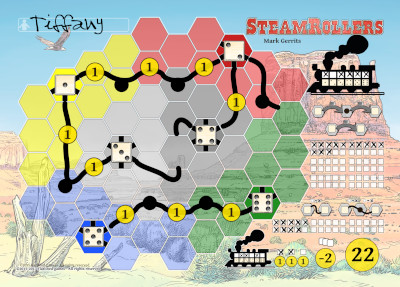
Scoring example : Tiffany scored 13 points from deliveries during the game. Her railway
network is worth 9 points (4 city-to-city connections, and 5 towns crossed). She has an
engine of 5, worth 2 bonus points. She also hold action tiles worth -2 points. Her
final score is 22 points (13+9+2-2).
Solitaire game
This variant allows you to play alone against Olivia, SteamRollers' artificial
intelligence.
In the English Original, the Solo opponent is called Olive. On Yucata, she plays both
English and German players, so she agreed to be called Olivia by everybody.
Olivia also uses one individual sheet, but instead of drawing rails she crosses off
hexes to indicate her growing influence in the map's six regions.
Setup
The game is set up as usual with the following differences:
-
When you draw the goods during setup, line them up in random order on the cities
(see example).
-
You can play in Medium or Hard mode, just as in a normal game. Only draw the
borders on your individual sheet.
-
The alternate action tile 2 for solo play is used instead of the normal action tile
2.
Alternate solo action tiles
 2a:
2a: Re-roll Olivia's white dice before phase 1 of her turn.
 2b:
2b: Prevent Olivia from removing a cube during phase 4. Instead, she
crosses off an empty hex in that region.
-
Amongst the optional rules, only the medium and hard setup rules (mountains) can be
used. No Coal (black) goods, no starting powers, no order tiles.
-
Olivia starts the game with some influence on the map. Choose the difficulty level
you want and roll the corresponding number of dice. Cross off one empty hex in the
region rolled on each die (see example).
Olivia's Difficulty Levels
| Clerk | - 1 die |
| Conductor | - 2 dice |
| Machinist | - 3 dice |
| Engineer | - 4 dice |
| Investor | - 5 dice |
| Rail Baron | - 6 dice |
The player turn
On each turn, roll three white dice and the black special die. Use two white dice to
perform two actions. Then Olivia will use the remaining white die for her action.
Play as usual, but you perform two actions per turn. The black die is the same for both
actions. Ignore the order of the goods when delivering as it is only used during
Olivia’s turn. You may choose any good to deliver that matches the destination city
color.
One rule changes: each permanent action tile (showing the ∞ symbol)
can only be used for one of your actions each turn.
Take two actions using two out of the three available white dice.
Olivia's turn
She uses the white die you left her and follows this sequence:
-
She crosses off an empty hex in the region corresponding to the die. The exact hex
crossed off does not matter, only the number of hexes crossed off in the region.
Olivia can cross off town hexes, but not cities. If all hexes in the region are
crossed off when Olivia must cross one, she immediately wins the game.
-
If you have a non-sideways action tile with the same number as Olivia's die, you
must return it next to the board.
-
If the city corresponding to her die is empty, Olivia re-rolls it and starts back at
step 1. (This means she could cross off hexes in different regions, or even several
hexes in the same region.)
-
If there are three or more hexes crossed off in Olivia’s die region, she removes the
last (rightmost) good in line from the corresponding city and earns points equal to
the number of crossed hexes in that region.
On yucata.de, Olivia does not cross off hexes on a map to track her progress.
Instead, her progress is tracked in a chart under the player information.
Olivia makes progress in the region corresponding to the third die. She will deliver
the rightmost good on the third progress step in a region and every step after that.
If she cannot deliver a good, she will get another roll. She wins immediately if she
completes progress for any region. She also forces you to return a non-sideways action
tile that matches her die.
Solitaire game end and scoring
The game ends as usual, when three cities are empty. The turn is completed (meaning
Olivia will always play last). You score points as in a normal game.
Olivia scores as follows:
- She scores points for deliveries in her phase 4
- She always scores 3 points for her engine (as if it was power 6)
-
For her network, Olivia adds the number of crossed hexes in the two regions where
she crossed the most. (She always scores exactly two regions, in case of ties only
2 regions are scored.)
-
Olivia then scores positive points for all the action tiles remaining near the board
(only score positive tiles, ignore the -2 tiles).
To win you must score more points than Olivia. A tie means you have lost.
The game ends as usual, when three cities are empty. To win you must score more points
than Olivia. A tie means you have lost.
If you have trouble distinguishing between the colors in this game, you can enable
"Colorblind assistance" in the options. This will label map hexes with numbers
that correspond to the hex's region. The good cubes are also labeled with the
numbers that correspond to the good's destination.
Grey cubes have the number "3", but they can still be delivered to either city 3 or
4 as usual. Coal (black wildcard cubes) have the letter "C".
Personal delivery goods (used in the starting power tiles microexpansion) are
indicated by a black or white dot on the good. When colorblind assistance is
enabled, they are indicated by a thicker border around the number. The option
"Show any personal good on the main map" will show those personal goods on
every main map view, even for the players that did not choose the personal good
starting power tile.